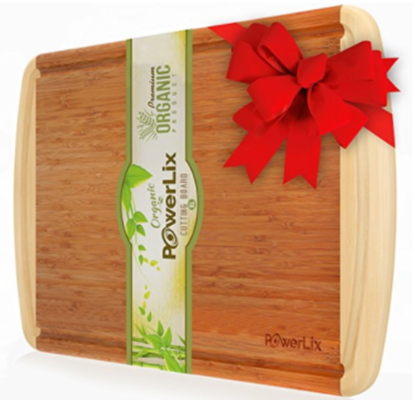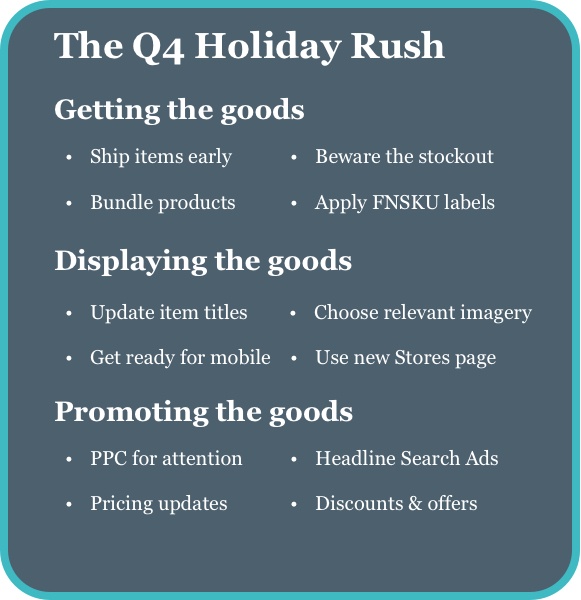Amazon owns the fourth quarter. At the end of each year, the platform reaches new e-commerce milestones and breaks its own records as customers flock to their most trusted source of holiday gift inspiration. More than half of online product searches in the US begin on Amazon.com to begin with, and in the fourth quarter this trend only heats up.
For merchants selling on Amazon, Q4 success is crucial because these three months can make or break a brand’s overall performance for the year. Some sellers will neglect to prepare, resulting in an untold number of sales lost to competitors. Meanwhile, others will stay ahead of the calendar, reap the benefits of thoughtful preparation, and experience Q4 as a truly wonderful time of year. This post explains how to earn your place in the second group.
Getting the goods
It all starts with inventory. If you have no product in stock or not enough to satisfy demand, the rest of the tips presented here won’t matter much. Inventory comes first, and you’ll need lots of it. It’s fairly typical to see the sales volume of a brand shoot up 400% or more during this holiday period.
Getting ahead of the rush matters a great deal here. You need to deliver a lot of your inventory for holiday sales to Amazon’s fulfillment centers by October. The time it takes for Amazon to receive and process new inventory goes up tremendously in the winter months, so don’t count on sending in products during the few weeks leading up to Christmas.
At the same time, you need to have new shipments of inventory ready to replenish Amazon’s diminishing stock as soon as you foresee a potential stockout—it’s a good idea to send in a new shipment several weeks before you think it’ll be needed. If you’re using a tool for forecasting inventory, make sure you understand how it works and have a good sense of how accurate it’s going to be. Some Fulfilled by Amazon (FBA) sellers will also need to increase inventory storage limits as they get ready.
Once you’ve got a handle on the scheduling aspect of holiday preparations, there are other aspects of inventory management that need to be addressed. For one, you should aim to sticker your own products with FNSKU labels, as opposed to paying Amazon to do it. This will help Amazon process your inventory more quickly and will result in fewer human errors in processing. And at $0.20 per unit, it’s likely to save you money too.

Finally, you may also want to consider bundling products. This is a popular method e-commerce merchants use to sell more product, and it’s worth considering. If you do this, of course, you’ll need to manage the inventory of all the items being bundled, so think through what combinations of products make the most sense and stock up well before the holiday rush starts.
Displaying the goods
In terms of listing optimization, there are some general tips to be aware of. First, you need to take into account how you rank on mobile devices, as these are what many (perhaps most) of your customers will use to view your product pages. Make sure you’re checking how your listing appears across various devices and browsers.
Next, try to improve upon the product images you’re now using. Could they be better? Could the images be made more relevant to the holiday season or could the products be characterized as gifts? Visuals are incredibly persuasive, and presentation matters even more when selling items that will be given as gifts.

Now, it’s time to take a look at your backend search terms and product titles. Search terms lead customers to your pages; without incorporating high-volume terms, you could lose some business. Product titles do the vital job of sparking interest and getting the customer to consider your product as a potential gift for someone, so you need to get the titles right. Make sure they’re rich with keywords.
You should strongly consider setting up your storefront using an Amazon Stores page (which is basically Amazon’s new take on a Brand Page). Vendors and sellers now both have access and can take a much more personal and unique approach to impressing customers. Any merchant would be wise to begin creating a new branded page and figuring out what works. If you build the page and troubleshoot it before the holiday rush, you could easily have an advantage by already knowing what works best. Branded pages are not common yet, but they will be soon. As an early adopter, you’ll have an edge over the competition.
Promoting the goods
After thinking about inventory and listing optimization, you’ll need to consider how you’ll promote your brand. Although this begins with the careful incorporation of search terms and keyword-rich product titles as mentioned above, it really kicks into high gear with paid promotions.
Pay-per-click advertising (PPC) is really useful in attracting customers at the top of the buying funnel. It’s vital that your brand has a PPC spend schedule that enables you to boost ads at the right times during the holiday sales rush.
You should specifically consider the value of Headline Search Ads, which display at the beginning of the page and put you in a position to be top-of-mind for consumers. Headline Search Ads are newly available in Seller Central, so you can bet your competitors will be using them. To ensure success this holiday season, every seller will need to understand how to use this new feature. Bundled products, recommended above, are just one of the many promotions that could be highlighted with headline ads.
During Q4, you’ll probably want to keep your automatic campaigns running. This is less about sales and performance during the holiday period and more about the benefits you’ll enjoy afterward. The data collected through these campaigns could end up being quite useful as January arrives and you want to extend the sales momentum of the holiday period. With a smart PPC strategy, it’s entirely possible to ride the holiday boom all the way into the next quarter.
Lastly, it’s quite important to weigh your options for pricing. It makes sense to evaluate your prices in comparison to your competitors’. Benchmarking prices can give you a sense of who’s got the advantage. From there you’ll have a clear idea of what quantity discounts, coupon offers, and other promotion strategies might encourage customer conversion and keep your brand competitive. Plus, the increased traffic in Q4 could lead to better results than these same offers have achieved for you in the past.
If getting ready sounds like a lot to do, just think through each of the different steps:

Final words
If you start planning now and keep working that plan throughout the fourth quarter, you’re likely to feel exhausted but elated when the new year rolls around. At least, that’s the goal. Then it won’t just be Amazon that owns the fourth quarter; you and your brand will too!
.png)

